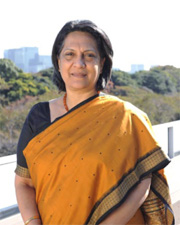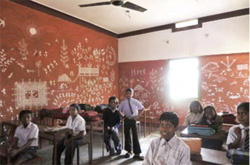Home > Highlighting JAPAN > Highlighting Japan DECEMBER 2012 > India-Japan Ties Grow Stronger
Highlighting JAPAN
INTERVIEW
India-Japan Ties Grow Stronger
2012 marks the sixtieth anniversary of the establishment of diplomatic ties between India and Japan. Alex Hendy of the Japan Journal asked Ambassador of India to Japan Ms. Deepa Gopalan Wadhwa about the nature of India-Japan relations today.

Credit: ALFIE GOODRICH
What have been some of the landmarks in India-Japan bilateral relations?
Ambassador of India to Japan Ms. Deepa Gopalan Wadhwa: We signed the Treaty of Peace and established diplomatic relations in April 1952, so this is a landmark year in our relationship. Thereafter, we had visits by both prime ministers in 1957, but then not again for more than twenty years. Now, we have annual summits between our prime ministers. In 2000 we established the Global Partnership between India and Japan, which was the beginning of a completely new phase in our relationship, and in 2006 this was broadened into the Global and Strategic Partnership. India is the only country with which Japan has formalized annual summits at the prime ministerial level; and for India, the only two such countries are Japan and Russia. This is a great indication of the closeness in our relationship.
What accounts for this special closeness?
India and Japan have a great cultural connection which goes back 1,400 years or more to Nara and Todai-ji temple. There is a lot of positive sentiment in our bilateral relations because of the cultural connections. The other thing that marks our bilateral relationship is that we carry no historical or ideological baggage. So we have the Buddhist connection and now, in contemporary times, we share a common value system as two democracies of Asia.
Economic relations are becoming increasingly close.
India was one of the first recipients of low-interest grant aid from Japan, and this has been a mainstay of the relationship over the years. In the last decade or so there has also been a very intense investment and trade relationship. In August of 2011 the Japan-India Comprehensive Economic Partnership Agreement (CEPA) took effect, which will eliminate about 94% of the tariffs between Japan and India within ten years. Already, within one year, we have seen growth of more than 20% in bilateral trade in goods and services. Two flagship projects are the Dedicated Freight Corridor (DFC) between Mumbai and Delhi, and the Delhi Mumbai Industrial Corridor (DMIC). These will see the emergence of many new DMIC townships on either side of the corridor and will transform India. Last year Prime Minister Noda committed 4.5 billion dollars [over five years] to these projects.
You have served as Ambassador to Japan for three months now. Have you identified any particular targets?
My first perceptions are that the relationship is extremely high on good sentiment and aspirations. I want to look at ways to give this potential concrete form, which means getting Japanese companies to go to India or to expand their base there. I also want to make sure that back home in India there is the support of infrastructure that encourages and facilitates the entry of Japanese companies into India. In October we held an energy dialog and looked at ways to get more Japanese companies to take their energy-efficient and alternative energy technologies to India. This meshes with India's new national manufacturing policy to provide a climate for foreign investment into India, both for the domestic market and also for global supplies. The automobile experience has been a happy experience [Maruti Suzuki brought an automobile revolution to India]. Can we replicate this in other areas?
The Wall Art Festival

A Warli painting in a classroom at a school in Bihar State's Sujita Village, where the first three Wall Art Festivals were held. The school building was constructed using donations from some fifty Japanese university students. The number of children who want to attend school is increasing.
From February 16–18, 2013, the 4th WAF will be held in Ganjad Village in the state of Maharashtra, which runs along the Arabian Sea. Ganjad is a village home to the Warli tribe. The Warli have preserved the practice of Warli painting, an ancient wedding custom in which pigments derived from mixing rice in water are used to paint the walls of newlyweds' future homes with images of a deity. At the coming WAF, local children will participate in a wall-painting activity to create a Warli painting on the wall of an elementary school. Events where children fly kites upon which they have written their dreams and mask-painting workshops will also be held. Three artists each from Japan and India will take part.
© 2009 Cabinet Office, Government of Japan






